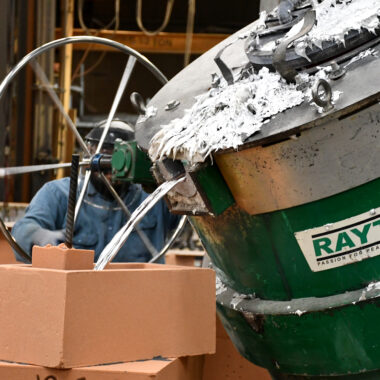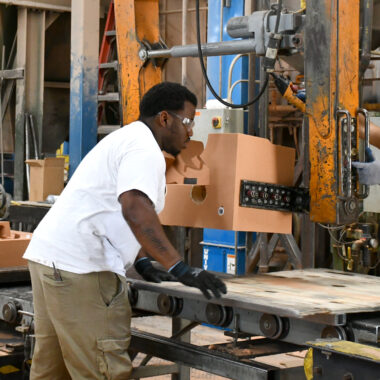Excellence in Aluminum Casting Illinois: Discover Our Craftsmanship
Excellence in Aluminum Casting Illinois: Discover Our Craftsmanship
Blog Article
The Ultimate Light Weight Aluminum Casting Handbook: Step-by-Step Recommendations for Success

Safety And Security Preventative Measures for Light Weight Aluminum Spreading

Additionally, preserving a neat workspace without mess can stop tripping threats and assist in the motion of workers during casting processes. aluminum casting illinois. Correct training in taking care of molten light weight aluminum and operating casting tools is important to decrease the risk of accidents and injuries. Routine equipment maintenance and examination ought to be conducted to determine and remedy any possible security risks immediately
Establishing Up Your Aluminum Spreading Work Space
Developing a risk-free and effective workspace for aluminum spreading is critical for making certain smooth operations and decreasing possible threats. Before establishing up your office, ensure that it is well-ventilated to stop the buildup of damaging fumes produced throughout the casting procedure. It is essential to have a designated area for each stage of the casting process, such as pattern production, mold and mildew prep work, and steel putting, to simplify operations and protect against cross-contamination.
Picking the Right Aluminum Alloy
To guarantee optimum casting leads to your safety-focused and well-organized office, choosing the proper aluminum alloy is critical. Different light weight aluminum alloys provide varied attributes such as strength, resilience, warm resistance, and machinability. The choice of alloy depends on the specific demands of your spreading job.
One typically utilized aluminum alloy for casting is A356. This alloy shows exceptional fluidity, making it perfect for intricate castings with slim wall surfaces. A356 additionally has good corrosion resistance and mechanical buildings, making it suitable for a variety of applications.
If higher visit homepage strength is required, 7075 light weight aluminum alloy is a preferred option. Understood for its high strength-to-weight proportion, 7075 is commonly used in applications where toughness is vital, such as aerospace parts.
For their website projects that entail high-temperature atmospheres, 319 aluminum alloy is an excellent alternative due to its remarkable thermal conductivity and resistance to thermal cracking.

Step-by-Step Aluminum Spreading Refine
Beginning the light weight aluminum casting process involves thorough preparation and adherence to a precise series of actions to guarantee the manufacturing of top notch spreadings. The primary step is pattern development, where a replica of the end product is made from steel, timber, or plastic. This pattern is then made use of to produce the mold, which can be constructed from products like sand or plaster. As soon as the mold and mildew is prepared, it is time to thaw the light weight aluminum in a furnace at temperature levels surpassing 1200 ° F.
After reaching the desired temperature level, the liquified aluminum is poured right into the mold and mildew dental caries. This action needs caution and precision to avoid problems in the final casting. The aluminum is delegated cool and strengthen inside the mold before it is eliminated for completing. Post-processing techniques such as grinding, sanding, and heat treatment may be employed to achieve the desired shape, here are the findings surface area finish, and mechanical residential or commercial properties.
Throughout the whole procedure, careful monitoring and quality assurance procedures need to be implemented to guarantee the last light weight aluminum spreading meets the called for criteria and specifications.
Tips for Perfecting Your Spreading Strategy
In refining your aluminum casting technique, precise interest to detail and adherence to accurate steps are extremely important to guaranteeing the production of high-grade spreadings. One critical pointer for developing your spreading method is to thoroughly prepare the mold and guarantee it is tidy and appropriately covered with a release representative to assist in the simple removal of the casting. Evaluating the spreading for any type of blemishes and making essential changes to the process will aid you enhance and ideal your aluminum casting technique over time.
Conclusion
To conclude, adhering to appropriate safety preventative measures, establishing up an ideal office, choosing the proper light weight aluminum alloy, and carefully following the detailed spreading procedure are vital for successful light weight aluminum casting. By paying attention to these crucial aspects and incorporating pointers to refine your strategy, you can achieve superb lead to your aluminum casting tasks.
From security precautions to developing spreading strategies, this handbook serves as a beacon of understanding for those venturing into the world of light weight aluminum spreading.
Beginning the light weight aluminum casting procedure entails precise prep work and adherence to a specific collection of steps to make certain the production of high-grade castings.In refining your aluminum spreading technique, thorough attention to information and adherence to specific steps are vital to ensuring the manufacturing of top quality spreadings. One crucial suggestion for improving your spreading technique is to thoroughly prepare the mold and guarantee it is tidy and effectively covered with a release agent to assist in the simple removal of the spreading. Evaluating the spreading for any imperfections and making necessary modifications to the procedure will certainly aid you boost and perfect your aluminum casting method over time.
Report this page